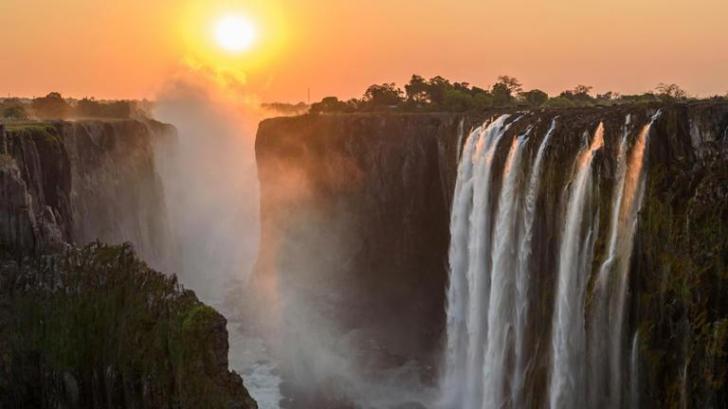News / Local
Victoria Falls in danger
13 Jul 2025 at 10:39hrs |
0 Views

One of Africa's most celebrated natural wonders, Victoria Falls, is facing mounting threats from climate-related water risks, particularly recurrent droughts, according to a newly released global analysis by the World Resources Institute (WRI) and Unesco.
The report, which examined 1,172 non-marine Unesco World Heritage Sites worldwide, found that 73% of these sites are exposed to at least one severe water-related threat - including drought, flooding, or pollution. Alarmingly, 21% of the sites face both extremes of too much and too little water in alternating years.
Victoria Falls, straddling the border between Zimbabwe and Zambia, is among the sites flagged as increasingly vulnerable due to persistent droughts linked to shifting rainfall patterns and intensifying climate change.
Once famed for its thundering cascades and lush rainforest ecosystem, the site - inscribed as a Unesco World Heritage Site in 1989 - has, in recent years, experienced periods where the mighty Zambezi River's flow dwindled to a near trickle. Severe droughts were recorded in 2016, 2019, and 2024, with rainfall arriving later each year, prolonging dry spells that damage ecosystems and disrupt livelihoods.
The report warns that the site's vulnerability threatens both its ecological integrity and economic sustainability.
Under normal conditions, more than one million tourists visit Victoria Falls annually, making it a vital pillar of the tourism economy for both Zimbabwe and Zambia. Thousands of jobs - from tour guides to hotel staff and craft vendors - depend on the attraction. Moreover, the Zambezi River feeds hydroelectric dams downstream, providing power across the region.
"When the Falls suffer, people suffer," the report states.
In 2019, a year of severe drought, Zimbabwe recorded over 300 human-wildlife conflicts as animals roamed in search of food and water. Meanwhile, 45 million people across southern Africa required food aid due to widespread crop failures. Power blackouts lasting up to 18 hours per day were experienced in Zimbabwe and Zambia as dam levels dropped, crippling economies and stalling climate resilience efforts.
Although the report classifies Victoria Falls as having "medium drought risk" - in part due to relatively low human development density around the site - the probability of future droughts remains high, reinforced by recent trends and climate modelling.
Additionally, infrastructure expansion linked to tourism is placing growing stress on the fragile environment.
"The concern is not just about how often droughts are occurring, but whether the environment and communities have time to recover before the next crisis hits," said report authors Samantha Kuzma (WRI) and Tales Carvalho Resende (Unesco).
Globally, other iconic heritage sites grappling with similar water-related challenges include the Taj Mahal in India, Angkor in Cambodia, Yellowstone National Park in the US, and Mt. Everest's Sagarmatha National Park in Nepal.
Despite these dire warnings, WRI says solutions remain within reach. These include improved water management policies, investment in drought-resilient infrastructure, and integrating climate risk assessments into tourism and conservation planning.
As southern Africa braces for another uncertain rainy season, the future of Victoria Falls - and the millions who depend on it - may depend on how urgently leaders act on the warnings from climate scientists and conservationists.
The report, which examined 1,172 non-marine Unesco World Heritage Sites worldwide, found that 73% of these sites are exposed to at least one severe water-related threat - including drought, flooding, or pollution. Alarmingly, 21% of the sites face both extremes of too much and too little water in alternating years.
Victoria Falls, straddling the border between Zimbabwe and Zambia, is among the sites flagged as increasingly vulnerable due to persistent droughts linked to shifting rainfall patterns and intensifying climate change.
Once famed for its thundering cascades and lush rainforest ecosystem, the site - inscribed as a Unesco World Heritage Site in 1989 - has, in recent years, experienced periods where the mighty Zambezi River's flow dwindled to a near trickle. Severe droughts were recorded in 2016, 2019, and 2024, with rainfall arriving later each year, prolonging dry spells that damage ecosystems and disrupt livelihoods.
The report warns that the site's vulnerability threatens both its ecological integrity and economic sustainability.
Under normal conditions, more than one million tourists visit Victoria Falls annually, making it a vital pillar of the tourism economy for both Zimbabwe and Zambia. Thousands of jobs - from tour guides to hotel staff and craft vendors - depend on the attraction. Moreover, the Zambezi River feeds hydroelectric dams downstream, providing power across the region.
"When the Falls suffer, people suffer," the report states.
Although the report classifies Victoria Falls as having "medium drought risk" - in part due to relatively low human development density around the site - the probability of future droughts remains high, reinforced by recent trends and climate modelling.
Additionally, infrastructure expansion linked to tourism is placing growing stress on the fragile environment.
"The concern is not just about how often droughts are occurring, but whether the environment and communities have time to recover before the next crisis hits," said report authors Samantha Kuzma (WRI) and Tales Carvalho Resende (Unesco).
Globally, other iconic heritage sites grappling with similar water-related challenges include the Taj Mahal in India, Angkor in Cambodia, Yellowstone National Park in the US, and Mt. Everest's Sagarmatha National Park in Nepal.
Despite these dire warnings, WRI says solutions remain within reach. These include improved water management policies, investment in drought-resilient infrastructure, and integrating climate risk assessments into tourism and conservation planning.
As southern Africa braces for another uncertain rainy season, the future of Victoria Falls - and the millions who depend on it - may depend on how urgently leaders act on the warnings from climate scientists and conservationists.
Source - Southern Eye
Join the discussion
Loading comments…
































